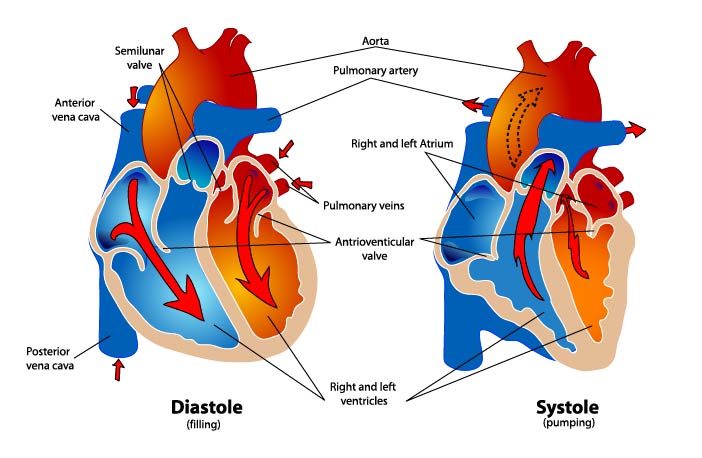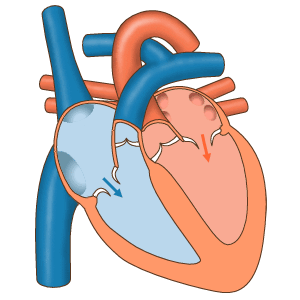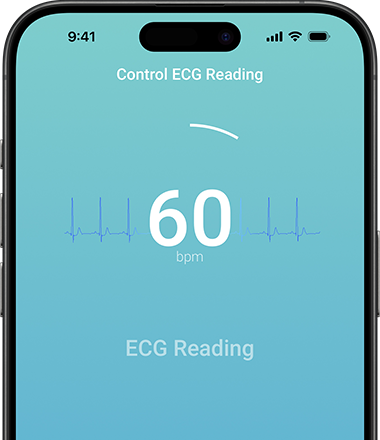The Healthy Heart
A healthy heart is the motor of every life. It supplies the body with oxygen and nutrients via the blood. It transports waste materials to the lungs and kidneys, among other organs, so that they can be eliminated from the body. All of this is made possible by regular contraction of the heart, which pumps approximately 100 milliliters of blood throughout the bodily circulation with each beat. The heart is slightly larger than a man’s closed fist and weighs, for adults, approximately 300 grams. It is located in the middle of the chest behind the sternum, tilted slightly to the left.
How does a healthy heartbeat function?
How high is a healthy heartrate?
What is the correlation between heartrate and a healthy lifestyle?
How is the Heart Arranged?
The heart is a hollow organ, and is largely composed out of muscle tissue. The Cardiac Septum divides the heart into a left and a right half; furthermore, each half is subdivided into a Ventricle (lower portion) and an Atrium (upper portion). A mobile valve is located between the Atrium and the Ventricle on each side, which are responsible for ensuring that blood flows in the proper direction only (from the Atria to the Ventricles). There are also two semi-lunar valves, located at the exit of each Ventricle, which help regulate the blood flow to the bodily and lung circulation. The heart beats sixty to ninety times per minute, thereby pumping the Oxygen- and nutrient-rich blood to the organs.
Electrical impulses are responsible for a continuous heartbeat, which originate in the Sinus Node. The Sinus Node is located at the top of the Right Atrium, and is the natural Pacemaker of the heart. The electrical signals, via a conduction system, then activate the musculature of the Atria, reach the AV Node, and finally arrive at the Ventricles, where a muscular contraction is triggered. This musclar contraction is a healthy heartbeat.
How does a healthy heartbeat function?
A healthy heartbeat is made up of two phases. In the filling phase (Diastole), Oxygen-poor blood flows from the bodily circulation back into the Right Atrium, through the valve, and into the Right Ventricle. At the same time Oxygen-rich blood flows out of the lungs, into the Left Atrium, through the valve and into the Left Ventricle. The contraction phase (Systole) follows: the heart muscle contracts, the valves between the Atria and the Vetricles close, the pressure in the Ventricles rises and the Semi-lunar valves to the body and lungs open. Through this mechanism, the Oxygen-poor blood from the Right Ventricle is pumped to the lungs, and the Oxygen-rich blood to the bodily circulation. While the Ventricles are emptying, the Atria are already filling with new blood, and the circulation begins again from the beginning. How frequently the heart beats in order to pump blood throughout the body is called the heartrate.
How high is a healthy heartrate?
The heartrate describes the number of measured beats per minute (bpm)—this number is an indicator of the workload of the Cardiovascular System.
The classification of heartrate is dependent upon whether the rate is low, normal or high:
- Bradycardia: decreased heartrate
- Normofrequent: normal heartrate
- Tachycardia: elevated heartrate
The heartrate is dependent upon many factors, of which age and physical condition play a large role.
When in a state of rest, the heartrate is called the „resting pulse“ or „resting heartrate,“ and gives information regarding the condition of the heart. The standard values for resting pulse according to gender, age and physical fitness are shown in the table below. If your measured reading falls outside of your expected range, we recommend further follow-up with your doctor.
Figure: Resting pulse for males, classified by age and physical fitness 1.
| MALE / Physical Fitness | 18-25 years | 26-35 years | 36-45 years | 46-55 years | 56-65 years | 65+ years |
|---|---|---|---|---|---|---|
| Athlete | 49-55 | 49-54 | 50-56 | 50-57 | 51-56 | 50-55 |
| Excellent | 56-61 | 55-61 | 57-62 | 58-63 | 57-61 | 56-61 |
| Good | 62-65 | 62-65 | 63-66 | 64-67 | 62-67 | 62-65 |
| Above Average | 66-69 | 66-70 | 67-70 | 68-71 | 68-71 | 66-69 |
| Average | 70-73 | 71-74 | 71-75 | 72-76 | 72-75 | 70-73 |
| Below Average | 74-81 | 75-81 | 76-82 | 77-83 | 76-81 | 74-79 |
| Poor | 82+ | 82+ | 83+ | 84+ | 82+ | 80+ |
Figure: resting pulse for females, classified by age and physical fitness 2.
| FEMALE / Physical Fitness | 18-25 years | 26-35 years | 36-45 years | 46-55 years | 56-65 years | 65+ years |
|---|---|---|---|---|---|---|
| Athlete | 56-60 | 54-59 | 54-59 | 54-60 | 54-59 | 54-59 |
| Excellent | 61-65 | 60-64 | 60-64 | 61-65 | 60-64 | 60-64 |
| Good | 66-69 | 65-68 | 65-69 | 66-69 | 65-68 | 65-68 |
| Above Average | 70-73 | 69-72 | 70-73 | 70-73 | 69-73 | 69-72 |
| Average | 74-78 | 73-76 | 74-78 | 74-77 | 74-77 | 73-76 |
| Below Average | 79-84 | 77-82 | 79-84 | 78-83 | 78-83 | 77-84 |
| Poor | 85+ | 83+ | 85+ | 84+ | 84+ | 84+ |
The maximum heartrate is the rate which may be reached in the setting of maximum endurance. This is a number that varies from person to person, but typically decreases with age. Your exact maximum heartrate can be determined in collaboration with your doctor.
What is the correlation between heartrate and a healthy lifestyle?
If the heartrate lies above the expected resting pulse value, the heart muscle may be in need of training. A high heartrate can be a sign of stress or of poor physical condition. With help from exercise, frequent movement and proper nutrition, the circulation and the heart muscle can become trained. In some cases a prolonged elevated heart may lead to heart rhythm disorders, i.e. Atrial Fibrillation. If untreated, this can increase the risk of Stroke.
When beginning or returning to exercise, it is important not to overburden the heart. For example, after an operation, a physical goal is often to strengthen the body as well as the heart muscle. As heartrate is a helpful indicator of stress to the heart, a medical heartrate monitor may be a helpful tool in order to reintroduce activity safely. And so it is: the higher the physical stress, the more Oxygen the body needs. The heart must therefore increase the frequency at which it beats in order to pump enough Oxygen-rich blood throughout the body. For a trained athlete the heart doesn’t need to beat as quickly to circulate blood, as is necessary for somebody who is less physically fit.



